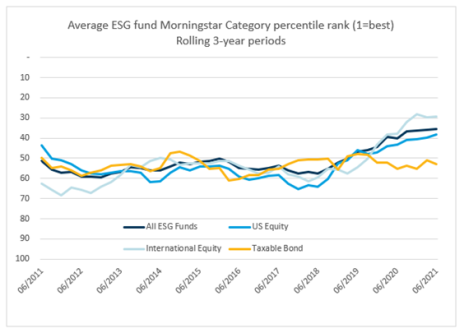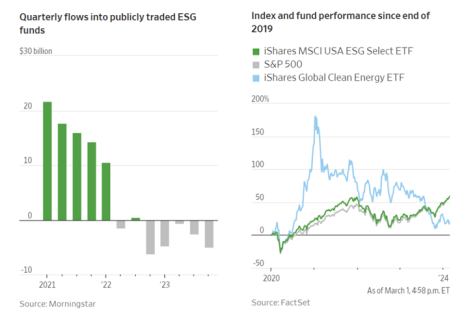ESG (Environmental, Social and Governance) investing actually began in the 1960s, called socially responsible investing back then. The catalyst that started the practice was when investors decided not to invest in stocks or industries such as tobacco or companies/countries involved with the South African apartheid regime.
Fast forward to the 1980s, the practice was renamed “corporate social responsibility” (CSR) and businesses started to recognize that investors wanted them to be more socially and environmentally responsible.
But it took another 20 years until the movement became commonplace, under the ESG title.
[text_ad]
Many investors jumped on the bandwagon, spawning numerous ETFs and funds, globally. And while you may have heard that ESG investing never measured up to the broad market returns, that’s not exactly correct. Worldwide, Charles Schwab says that “ESG Leaders earned an average annual return of 12.9%, compared to an average 8.6% annual return earned by Laggard companies. This represents an approximately 50% premium in terms of relative performance by top-rated ESG companies.”
The company’s report went on to say, “In the United States, the country with the largest number of rated companies, the ESG Leaders earned an average annual return of 20.3%, compared to a 13.9% average annual return earned by Laggard companies.”
And as you can see in the following graph, ESG returns have held their own against the broader indexes.
Source: Charles Schwab Investment Advisory, Morningstar Direct
However, the ESG market is, well, you can say “transitioning.” That is, ESG investments are once again being renamed to “transition funds.”
One of the reasons is most likely due to a lessening interest in this arena. As you can see from the following funds flow charts, investor interest in the ESG marketplace is waning.
Part of the problem is the difficulty in bestowing an ESG rating. ESG rating firms such as CDP and ISS-ESG measure the environmental, social, and corporate governance practices of the businesses. And even investment rating service Morningstar now has ESG ratings. But the challenge is that it is an onerous task to measure a company on its ESG governance because so many parameters are qualitative instead of quantitative.
Added to that is the current toxic political environment. BlackRock, the world’s biggest asset manager, has recently kicked ESG investing to the curb, after the backlash against “woke capitalism.”
Lastly, active ESG funds have always been a tad more expensive than their non-ESG brethren or passive ESG funds, so investors who compared their net returns often found those extra expenses weren’t worth the “good” feelings that came with investing in ESG.
But those issues don’t mean that BlackRock (or others) is abandoning its social/environmental consciousness. It is still fighting the climate change fight, only now in a different manner. For example, BlackRock says it is “no longer pushing for changes in corporate behavior, talking about hard-to-quantify social issues or actively promoting ESG investing criteria. Instead, it is directing billions of client dollars toward infrastructure projects that will help speed the transition from fossil fuels.”
Consequently, the company is turning its efforts toward what is now called transition investing. Lest you think that BlackRock actually coined that term, think again. The first reference I could find related to energy transition and transition investing was actually used by former President Jimmy Carter in a 1977 speech.
BlackRock is walking the walk, too. The company has just joined Brookfield Asset Management in a $12.5 billion deal to buy Global Infrastructure Partners, an infrastructure fund manager that owns and operates energy, transportation, and waste and water companies around the world.
Also, BlackRock offers infrastructure funds that invest in solar power, natural gas made from food waste and cow manure, and removing carbon from the atmosphere.
But BlackRock is not the only fund manager getting into the act. Transition investing is taking on a life of its own. The formal definition is “allocations that finance progress towards net zero (emissions from carbon-intensive industries such as oil, mining, or machine materials).” It involves investing in companies and industries that are actively helping energy transition, as well as providing financing to high-emitting sectors to aid them in “implementing their climate strategies.”
And this investment trend with sustainable funds is ratcheting up, with cumulative inflows of $57 billion worldwide in the first half of 2023, bringing total assets under management to more than $3.1 trillion, or almost 8% of total global assets under management.
The International Energy Agency predicts that capital investment in the energy sector to surge to $4 trillion per year by 2030, reflecting the growth in wind, solar, hydrogen pipelines, and grid infrastructure. BlackRock says, “Over the next 30 years, we believe this focus will extend to clean hydrogen, carbon capture, and low-carbon aviation fuels.”
With that in mind, I took a look at the numerous “transition funds” now available to investors, and I found these three that look interesting:
· Blackrock U.S. Carbon Transition Readiness ETF (LCTU); top three sectors: Technology, 29.19%; Financial Services, 13.35%; and Healthcare, 12.82%; expense ratio 0.14%.
· Sprott Junior Uranium Miners ETF (URNJ); fully invested in Energy, 87.60% and Basic Materials, 12.40%; expense ratio 0.80%.
· Neuberger Berman Carbon Transition & Infrastructure ETF (NBCT), top three sectors: Industrials, 42.37%; Utilities, 25.30%; and Basic Materials, 14.60%; expense ratio 0.55%.
As always, please make sure that any investment meets your personal strategies, goals, and risk preferences.
[author_ad]



